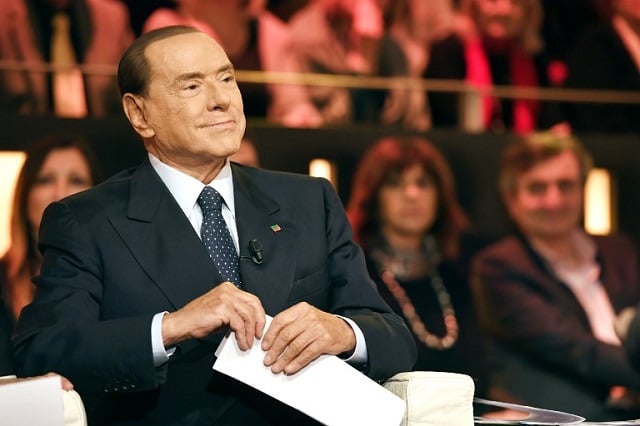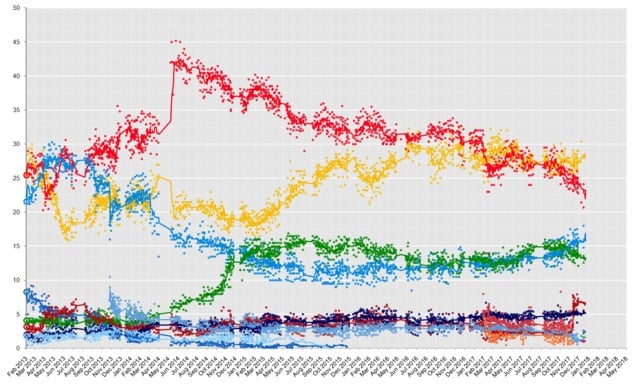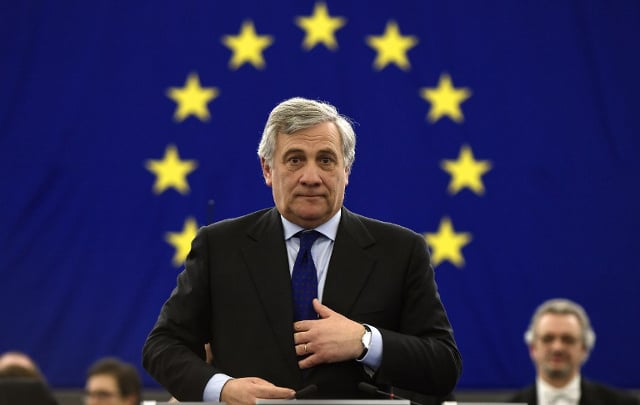Political cheat sheet: Understanding Silvio Berlusconi's Forza Italia party

As part of our introductions to Italy's main political parties ahead of the 2018 general election, we take a look at the party led by Silvio Berlusconi and the senior ally in his centre-right coalition: Forza Italia (FI).
Origins
The first thing to know about FI is that it was launched in its current form in late 2013, but first existed between 1994-2009. There are some key differences between the two incarnations of the party, most notably that the current FI is much smaller, due to several splits and break-away movements (several are listed here).
The original Forza Italia was a centre-right party founded by Silvio Berlusconi in 1993. It burst onto the political scene as a fresh new voice, taking advantage of a moment of crisis following the Mani Pulite investigation which had uncovered corruption in most of Italy’s main parties at the time.
Berlusconi launched a centre-right alliance in 2007, the People of Freedom (PdL), which became a full political party two years later and governed in coalition with the Northern League. But in 2013, that party was dissolved following a vote, and the new Forza Italia was born.
Read our guides to Italy's other main parties:
-
Understanding the Northern League
-
Understanding the Five Star Movement
-
Understanding the Democratic Party
-
An introduction to Italy's small political parties

Silvio Berlusconi speaks on Italian television. Photo: Andreas Solaro/AFP
Ideology
FI is centre-right and the party today is more liberal than the earlier Forza Italia, as some of the more rightwing and conservative factions formed separate parties. But FI is still very diverse, encompassing multiple factions. The party's own constitution says it is based on "the ideals of liberal democratic, liberal Catholic, secular and reformist European traditions".
So what does that mean?
The party is much more pro-EU than its coalition allies in the 2018 election, and belongs to the European People's Party. It also supports close relations with both Russia – Berlusconi and Russian President Vladimir Putin are old friends – and the United States.
It's pro-business, which is no surprise given Berlusconi's background as a media magnate, and is supportive of low tax rates for business-owners and the wealthy. And it's recently taken a swing to the right on migration, with the party leader pledging to deport 600,000 illegal immigrants from the country if successful in the election, and to block new arrivals.
-
What you need to know about Italy's 2018 election
-
Who's who in the Italian general election?
-
These are the promises Italy's political parties have made to voters
Support
The graph below (FI is shown in light blue) shows opinion polling ahead of the 2018 election. (The data from before November 2013 refers to FI's predecessor, the People of Freedom (PdL) party, and the split which took place between the new FI and the New Centre-Right (NCD – now the Popular Alternative) partly explains the drop in support after that.)
Municipal elections in 2017 showed the party was on the rise as it took control of Genoa in the north and the Sicilian governorship. And although it is predicted to receive fewer votes than in the 2013 election, Berlusconi's strength has always been in coalition-building. This time, he's allied himself with two parties further to the right, the Northern League and Brothers of Italy, and in early February, polls were showing the alliance at 35-37 percent of the vote, not far off the 40 percent threshold needed to govern.

In this graph of Italian political opinion polls from February 2013 to January 2018, Forza Italia is marked in light blue, and seen as the third most popular single party as of January 2018. Graph: Impru20/Wikimedia Commons
READ ALSO: How does Italy's electoral law actually work?
Key players
The party is led by Silvio Berlusconi, and it's fair to say that a lot of its supporters cast their votes solely for him. This might strike international observers as odd, since the four-time PM is currently ineligible to hold public office. But though the man famed for his "Bunga Bunga" sex parties and serial off-colour gaffes has been written off as a political force time and again, he always seems to come back fighting.
READ ALSO: Eight things that explain the enduring popularity of Silvio Berlusconi
Antonio Tajani is one of the likeliest Forza Italia candidates for prime minister in the upcoming election. He became President of the European Parliament in January 2017 after previous roles in the European Commission and as an MEP. Tajani was also one of the founding members of the original Forza Italia in 1994, and acted as Berlusconi's spokesperson in his first government.

Antonio Tajani reacts after his election. Photo: Frederick Florin/AFP
Renato Brunetta is the party's leader in the Chamber of Deputies, Italy's Lower House of Parliament, and was Italian Minister for Public Administration and Innovation between 2008 and 2011. The Venetian has a background in academia and journalism, with roles as an economics professor and economic adviser for three Italian Prime Ministers on his CV.
Giovanni Toti is the president of Liguria in northwestern Italy. After some time in the youth wing of the Italian Socialist Party, Toti became an intern at the Berlusconi-founded Mediaset broadcaster, and rose up the ranks there before entering politics in 2014 as an advisor to Forza Italia.
READ ALSO: Ten things to know about the Italian political system
Comments
See Also
Origins
The first thing to know about FI is that it was launched in its current form in late 2013, but first existed between 1994-2009. There are some key differences between the two incarnations of the party, most notably that the current FI is much smaller, due to several splits and break-away movements (several are listed here).
The original Forza Italia was a centre-right party founded by Silvio Berlusconi in 1993. It burst onto the political scene as a fresh new voice, taking advantage of a moment of crisis following the Mani Pulite investigation which had uncovered corruption in most of Italy’s main parties at the time.
Berlusconi launched a centre-right alliance in 2007, the People of Freedom (PdL), which became a full political party two years later and governed in coalition with the Northern League. But in 2013, that party was dissolved following a vote, and the new Forza Italia was born.
Read our guides to Italy's other main parties:
- Understanding the Northern League
- Understanding the Five Star Movement
- Understanding the Democratic Party
- An introduction to Italy's small political parties

Silvio Berlusconi speaks on Italian television. Photo: Andreas Solaro/AFP
Ideology
FI is centre-right and the party today is more liberal than the earlier Forza Italia, as some of the more rightwing and conservative factions formed separate parties. But FI is still very diverse, encompassing multiple factions. The party's own constitution says it is based on "the ideals of liberal democratic, liberal Catholic, secular and reformist European traditions".
So what does that mean?
The party is much more pro-EU than its coalition allies in the 2018 election, and belongs to the European People's Party. It also supports close relations with both Russia – Berlusconi and Russian President Vladimir Putin are old friends – and the United States.
It's pro-business, which is no surprise given Berlusconi's background as a media magnate, and is supportive of low tax rates for business-owners and the wealthy. And it's recently taken a swing to the right on migration, with the party leader pledging to deport 600,000 illegal immigrants from the country if successful in the election, and to block new arrivals.
- What you need to know about Italy's 2018 election
- Who's who in the Italian general election?
- These are the promises Italy's political parties have made to voters
Support
The graph below (FI is shown in light blue) shows opinion polling ahead of the 2018 election. (The data from before November 2013 refers to FI's predecessor, the People of Freedom (PdL) party, and the split which took place between the new FI and the New Centre-Right (NCD – now the Popular Alternative) partly explains the drop in support after that.)
Municipal elections in 2017 showed the party was on the rise as it took control of Genoa in the north and the Sicilian governorship. And although it is predicted to receive fewer votes than in the 2013 election, Berlusconi's strength has always been in coalition-building. This time, he's allied himself with two parties further to the right, the Northern League and Brothers of Italy, and in early February, polls were showing the alliance at 35-37 percent of the vote, not far off the 40 percent threshold needed to govern.

In this graph of Italian political opinion polls from February 2013 to January 2018, Forza Italia is marked in light blue, and seen as the third most popular single party as of January 2018. Graph: Impru20/Wikimedia Commons
READ ALSO: How does Italy's electoral law actually work?
Key players
The party is led by Silvio Berlusconi, and it's fair to say that a lot of its supporters cast their votes solely for him. This might strike international observers as odd, since the four-time PM is currently ineligible to hold public office. But though the man famed for his "Bunga Bunga" sex parties and serial off-colour gaffes has been written off as a political force time and again, he always seems to come back fighting.
READ ALSO: Eight things that explain the enduring popularity of Silvio Berlusconi
Antonio Tajani is one of the likeliest Forza Italia candidates for prime minister in the upcoming election. He became President of the European Parliament in January 2017 after previous roles in the European Commission and as an MEP. Tajani was also one of the founding members of the original Forza Italia in 1994, and acted as Berlusconi's spokesperson in his first government.

Antonio Tajani reacts after his election. Photo: Frederick Florin/AFP
Renato Brunetta is the party's leader in the Chamber of Deputies, Italy's Lower House of Parliament, and was Italian Minister for Public Administration and Innovation between 2008 and 2011. The Venetian has a background in academia and journalism, with roles as an economics professor and economic adviser for three Italian Prime Ministers on his CV.
Giovanni Toti is the president of Liguria in northwestern Italy. After some time in the youth wing of the Italian Socialist Party, Toti became an intern at the Berlusconi-founded Mediaset broadcaster, and rose up the ranks there before entering politics in 2014 as an advisor to Forza Italia.
READ ALSO: Ten things to know about the Italian political system
Join the conversation in our comments section below. Share your own views and experience and if you have a question or suggestion for our journalists then email us at [email protected].
Please keep comments civil, constructive and on topic – and make sure to read our terms of use before getting involved.
Please log in here to leave a comment.